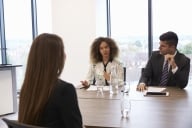You have /5 articles left.
Sign up for a free account or log in.
It's been more than 10 years since we started using videoconferencing to save on candidate travel costs for colleges that hire us to assist with administrative searches. And although videoconferencing has always been a good way to interview semifinal candidates, modern methods have now greatly reduced most technical difficulties. Even though glitches still arise from time to time, it’s clear that videoconferencing is here to stay – even though some search committees and some candidates haven't quite mastered it.
On average, our client colleges (generally community colleges looking for senior administrators) have applicant pools of 60 to 70 potential candidates. After a committee narrows the field to about a dozen applicants, typically our client colleges elect to interview those 12 individuals using videoconference. When the committee has once again narrowed the field to three or four, those individuals come to campus for a full day of interviews with various constituent groups.
Both candidates and the committee members who interview them should fully understand the videoconferencing process. Some of the issues would apply to in-person interviews as well, but when you aren’t in the same room, it’s all the more important to get these things right.
Suggestions for Search Committees:
- Well before the videoconference, send the candidates a package of materials with information about both the college and the position. Don’t forget to include a list of committee members and their titles.
- About five minutes before the interview begins, send a list of questions to the candidate. This way, you are not allowing the candidate to rehearse answers, but you are allowing him or her to read along. This is especially helpful if there is a blip in the audio.
- Assign a committee member the task of “framing up” each candidate. Think about how you see news broadcasters, with the face and upper torso taking up most of the screen, and aim for that view. At this point, make sure the candidate can hear and see the committee. Every candidate should have a similar framing, so that the candidate is looking straight ahead at the camera rather than at an angle.
- As an ice-breaker, the committee chair should give a brief overview of the interview process, including how many questions they’ll be asking and the amount of time that has been allotted for the interview.
- Assign a committee member to be the time keeper. Midway through the interview, tell the candidate how he or she is doing on the time given versus the number of questions that are left. For example, “We’re about midway through the time and have over half of the questions to go. You might need to speed up with your answers just a little.” As a courtesy to the candidate, give another update on time a question or two later in the interview.
- Raise your hand and give your name as you begin to speak. This will help the candidate to pick you out within the group. Remember, you have a great view of the candidate, but the candidate doesn’t have the same clear view of individuals in the hiring committee.
- Be sure to maintain order when the committee is answering questions from the candidate. The person who asked this “closing” question should be positioned in a location where he or she can easily see all the committee members in the room. When the candidate asks a question, the committee member who asked the “closing” question should direct the answer to a particular committee member who has knowledge of the subject. Or, watch for one of the committee members to signal that he or she would like to answer the question.
- Remember, the candidates can see what you’re doing. So, this is not the time for cross-stitching. Yes, a committee member really did begin cross-stitching during a videoconference interview. Also, the microphones are extremely sensitive, so the candidate can hear everything that is said, even a whisper.
Suggestions for Candidates:
- Take a bottle of water to the interview site. Also, remember to keep on hand any materials that the college sent to you in advance of the interview – especially the list of the search committee members.
- Most of the sites will have a desk or table for you to sit behind. This is the preferred arrangement for most candidates. Place any items you want near you off camera or to the side of the desk. You don’t want the papers to shuffle next to your microphone or to appear sloppy or disorganized.
- There are some systems that have a camera that will focus automatically on whoever is talking. I’ve found that most candidates prefer to have a stationary camera and an unchanging view of the entire committee. While the picture of each face is not as clear, if the committee members raise their hands as they begin to speak, you will be able to tell who is talking.
- Smile at the camera. You will not have the benefit of meeting the committee members in person and shaking their hands; however, a smile will help you appropriately begin the interview.
- Look at the camera. The camera serves as the committee’s eyes and you’ll show the committee good eye contact if you look directly at the camera, rather than at the television screen.
- If you cannot hear the committee, don’t be shy. It is much better to tell the committee that you’re having some technical difficulties on your end. Keep your cool and remember, if the problems persist, disconnecting and then reconnecting will oftentimes solve the issue. I can assure you that the committee will discuss how you handled the difficulties.
- Lean forward. This will prove to the committee that you’re listening and interested in what they have to say.
- If your physical stature is short, take something to sit on in the chair. A large book works well. We want the committee to have a similar view of all the candidates, and this way they see your form from the upper torso, on up.
- Give plenty of time for the committee members to finish speaking before you start to talk. There will be a half-second delay on both ends. It is better to give a nonverbal sign such as a nod or a smile to indicate that you are listening and understand what is being said rather than to give verbal cues, such as “OK” and “Un huh.”
Finally, here are some general presentation tips to remember:
- Speak at a normal volume. Talking too loudly will give feedback on the committee’s end.
- Gesture naturally, but be careful not to wave your hands around too much. A lot of movement will appear as a blur on the screen. If you really need to get the viewer’s attention, consider making an “X” with your arms above your head.
- Blouses and shirts that are light pastels, muted colors, and have simple patterns or stripes come across best on camera. Rather than choosing a white blouse or shirt, consider wearing light blue. If you’re wearing a scarf or tie with your outfit, a contrasting color looks terrific with a light colored blouse or shirt. Very bright colors and all light or all dark clothing don’t pick up well on camera. Stay away from busy patterns on a tie or scarf.
- Avoid wearing excessive jewelry and having a lot of paper near the microphone. For example, bracelets and cuff links can clink on the desk near the microphones. Likewise, shuffling paper near the microphones is distracting.
Obviously, the videoconference interview does not replace the face-to-face interview, but it does have a number of benefits. With the cost of around $400 per candidate, it allows the committee and the candidates to interact more effectively than phone interviews. Saving costs gives the committee the freedom to interview a more diverse group of applicants, possibly increasing the number of minority candidates and those who have nontraditional backgrounds.
If you plan to use videoconferencing for your next search, keep these steps in mind and you can keep the whole process professional and effective.








